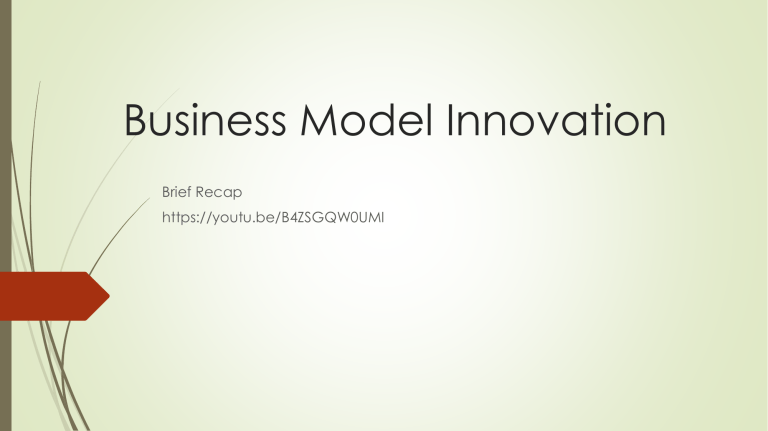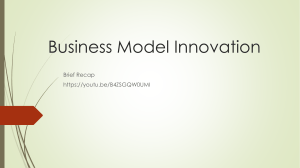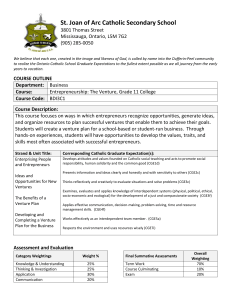
Business Model Innovation Brief Recap https://youtu.be/B4ZSGQW0UMI Innovation Strategies First Movers Versus Followers: A first-mover advantage is the gain that a firm attains when it is first to market a new product or enter a new market. Emergent industries are newly created or newly recreated industries formed by product, customer, or context changes Mature industries have slow revenue growth, high stability, and intense competitiveness. Growing industries exhibit moderate revenue growth and have moderate stability and uncertainty. The follower firm can learn from the pioneer’s mistakes and exploit the market potential created by the pioneer. Some firms successfully exploit a follower strategy. Many new ventures set a fast pace as they and their competitors enter a window of opportunity. Many start-ups exhibit a torrid pace due to a high sense of urgency, as illustrated by the causal diagram in Figure 5.2. Creativity and Invention Creativity is the ability to use the imagination to develop new ideas, new things, or new solutions. Creative ideas flow to invention, and invention flows to innovation Creative thinking is a core competency of most new ventures, and entrepreneurs strive to have creative people on their team. Creative ideas often arise when creative people look at established solutions, practices, or products and think of something new or different. The creative enterprise is based on six resources, as shown in Table 5.3 [Sternberg et al., 1997], To create something new, one needs knowledge of the field and of the domain of knowledge required. Domains are areas such as science, engineering, or marketing. Fields within a domain might be circuit design or market research. Wise, knowledgeable, creative people avoid being blinded or limited by their knowledge. The intuitive person suspends critical and conventional thinking long enough to consider the possibility of new solutions. One method of creative discovery includes the following steps: (1) slow down to explore different ideas, (2) read about the field, but not too much, (3) look at the available raw data, and (4) cultivate smart friends who have good intellectual skills [Paydarfar and Schwartz, 2001]. Creativity involves the ability to synthesize, working through information to come up with combing tions that are new and useful [Florida, 2002]. Incubation of the issues and time to reflect are important steps to creativity. One process of creative' thinking is shown in Figure 5.3. Types and Sources of Innovation Innovation is based on teamwork and creativity, and is d e fin e d as invention that has produced economic value in the marketplace. Innovation is based on the commercialization of new technology. An innovation can include new products, new processes, new services, and new ways of doing business. There are several different types of innovation, as illustrated in Figure. Incremental innovation is characterized by faster, better, and/or cheaper versions of existing products. Thus, they take an existing idea and creatively expand on it. Architectural innovation changes the way io which components of a product are linked together. Thus, the components remain unchanged, but the architecture of module connection is the innovation. (The overall architecture of the product describes how the components will work together.) The essence of an architectural innovation is the reconfiguration of an established system to link together existing components in a new way. Finally, radical innovation or disruptive innovation uses new modules and new architecture to create new products. The Internet is an example of a network system with new modules and new architecture - a radical or disruptive innovation. Disruptive innovation transforms the relationship between customer and supplier, restructures markets, displaces current products, and often creates new product categories [Leifer et al., 2000], Sources of innovation for new ventures include research laboratories, indJ pendent inventors, and universities [Branscomb et al., 1999]. In many areas if science and technology, universities can be an especially important source I f innovation. Professors and other university researchers are responsible for much cutting-edge research. Technology and Innovation Strategy An innovation strategy rests on the competencies and knowledge of the new firm. Continual product and process innovation can enable the firm to maintain a strategic advantage. Figure. illustrates the innovation and competition cycle between firms. Three dimensions of technological inventions impact the probability that they will be commercialized through a new firm formation: importance, radicalness, patent scope Importance reflects the magnitude of the economic value of an invention. The importance of an invention should increase the likelihood that a new firm will be founded to commercialize it because more important inventions have higher economic value and thus payoff to the entrepreneurs. Radicalness measures the degree to which an invention, regardless of economic value, differs from previous inventions in the field. Radical technologies destroy the capabilities of existing firms because they depend on new capabilities and resources; Finally, patent scope describes the breadth of intellectual property protection for the invention. These three dimensions of likelihood of commercilization are listed, in Table 5.4 We can portray the new business formation process for an invention as shown in Figure in next Slide. Using this process to review the potential of the Segway Human Transporter, one can obtain different conclusions for the various proposed uses: postal service, warehouse workers, or urban dwellers. Perhaps the best application for this device is not yet named. Often the disruptive technology will not immediately serve a mainstream market, as shown in figure . It will initially serve a niche market but will eventually enter the low end of the range of the mainstream market, as shown in figure . New Technology Ventures The new technology usually becomes available due to scientific discoveries or a new invention. Entrepreneurs find that this new technology may offer myriad opportunities for new ventures. The elements of an attractive innovation strategy are provided in Table 5.5 One way of describing the potential applications is to use the model shown in Table 5.6 Examples of new technologies that eventually found attractive economic applications include semiconductors, genomics, stents, and wireless telephone. All these technologies eventually traversed the four steps necessary for a favorable technology innovation, as shown in Figure . The innovation model shown in Figure can be used to illustrate new technology applications introduced today. Risk and Uncertainty Introducing a novel product into a new market has an uncertain outcome. An outcome resulting from an action is said to be certain in that it will definitely happen. Something certain is reliable or guarantee! An outcome resulting from an action is said to be uncertain in that the outcome is not known or is likely to be variable. Risk is the chance or possibility of loss. This loss could be financial, physical, or reputational. Risk is a measure of the potential variability of outcomes that will be experienced in the future. Furthermore, risk is the chance or possibility of loss. The entrepreneur-investor assumes the risk of the venture and should be willing to take on sizable risks with the knowledge that he or she can manage or mitigate them. The best method for most entrepreneurs is to use a form of experimentation— trial and error. Identify possible new ventures and take a few steps toward a business and then evaluate the early feedback Henry Ford said: “Failure is the opportunity to begin again, more intelligently," Entrepreneur-investors should consider the concept of regret, which we define as the amount of loss a person can tolerate. People treat regret of loss differently than the potential of possible gain The amount of risk entrepreneurs will endure varies, but most retain some personal financial reserve so that failure will not equate to homelessness or starvation. It is easier to be a risk taker if one has some reserves to fall back on. The risk-adjusted value of a venture, V, is V=U-λR (6.1) where U = upside, λ = risk-adjusted constant, usually greater than 1, and R = downside or regret. The larger the value of λ, the more risk-averse is the entrepreneur. We are neutral at λ = 1 but risk-averse at λ = 2 (Dembo and Freeman, 1998). If your regret is R = $110,000 and λ = 2, to proceed requires V > 0, or U > λR (6.2) Therefore, the required upside, U, is U > $220,000. Entrepreneurs can use scenarios and economic analysis to estimate the potential upside, U, of a venture. The strategic response to uncertainty is to build a venture in stages, reserving the right to adjust your core competencies and strategies, and play again at the next stage. Thus, reconsidering the case of the entrepreneur who is riskaverse with λ = 2 , he or she can choose to proceed for six months with the venture so that R = $55,000, and the minimum upside required is then only $110,000. After the six months, the entrepreneur adjusts the business strategy to improve the business performance and based on a new calculation of the upside, U, proceeds to a second stage of activity or decides to terminate the venture. Risk reflects the degree o f uncertainty and the potential loss associated with the outcomes, which m ay follow from an action or set o f actions. Risk consists o f two elements: the significance o f the potential losses and die uncertainty of those losses. In most new ventures, it is the significance or size of the potential losses, hazard, and the uncertainty that are estimated by new venture entrepreneurs and their investors. We propose a measure of risk as: Risk = hazard X uncertainty The hazard, H, is the size of the potential losses as perceived by the entrepreneurial team. Hazard is an entrepreneur’s income forgone (opportunity cost, OC) plus the financial investment, I, which he or she will need to make. Therefore, Risk = (I + OC) X UC (6.4) The uncertainty, UC, is measured by the variability in anticipated outcomes, which may be described by their estimate of the probability of loss (failure). Based on factors discussed , the entrepreneurial team may make a selection of a new venture (or to proceed or not), as shown in Figure 6.1. Technology ventures usually have four types of risk: technology, market, financial, and team. Every effort should be made to test the assumptions about these four sources of risk. Strategic risk management involves setting up strategies that anticipate the. downside of risk. The key to surviving risks is assessment and response [Slywotzky and Drzik, 2005] A process for managing risk and uncertainty is shown in Figure 6.2. One way to calculate an estimate of a new venture’s potential risk and reward is to answer the four questions posed in Table 6.3. In general, the entrepreneur seeks a venture where the return is expected to significantly exceed the potential losses. S c a le and S co p e: The scale of a firm is the extent of the activity of a firm as described by its size. The scale of a firmr’s activity can be described by its revenues, units sold, or some other measure of size. Economies of scale are expected based on the concept that larger quantities of units sold will result in reduced per-unit costs. Economies of scale are generally achieved by distributing fixed costs such as rent, general and administrative expenses, and other overhead over a larger quantity, q, of units sold. This effect is portrayed in Figure 6.3. The cost per unit decreases, reaching a minimum at qm. Often, the cost per unit will increase for q > qm, since the complexity of coordination may increase costs per unit for a high number of units Scalability refers to how big a firm can grow in various dimensions to provide more service. There are several measures of scalability. They include volume or quantity sold per year, revenues, and number of customers. These dimensions are not independent, as scaling up the size of a firm in one dimension can affect the other dimensions. Capacity is the ability to act or do something. Any firm has process assets, inventory, cash, and other factors that must be expanded as the company grows its sales volume. A firm that can easily grow its capacity is said to be readily scalable. The total cost, TC, of the production of units is described as: TC = FC + V C where FC is the fixed costs that do not vary with the quantity of production. The variable costs, VC, do vary with the quantity produced where VC - if X q, c being the cost/unit and the quantity being q. This relationship is shown in Figure 6.4. Table 6.4 describes the scalability and economies of scale for four types of businesses. The scope of a firm is the range of products offered or distribution channels utilized Cot both). The sharing of resources such as manufacturing facilities, distribution channels, and other factors by multiple products or business units gives rise to economies of scope The economies of scale, and scope both reduce the cost per unit. For a factory, its throughput—the amount processed within a given time—needs to be consistently high. Network Effects and Increasing Returns Network economies arise in industries where a network of complementary products is a determinant of demand (also called network effects) The overall tendency is toward “bigger is better.” As Figure 6.6 indicates, over time, a winner emerges (company A) and the competitors decline Increasing returns mean that the marginal benefits of a good or of an activity are growing with the total quantity of the good or the activity consumed or produced [Van den Ende and Wijaberg, 2003]. Increasing returns is the tendency for a company that is ahead, firm A in Figure 6.6, to get farther ahead. The theory is that the firm that has a successful product that is increasingly becoming the standard for the industry will experience increasing returns as increasing quantities are sold. . In the PC industry, Wintel captured the largest market share, with Apple holding about 10 percent of the market. In general, network effects exhibit reinforcing characteristics, as shown in Figure 6.7.





